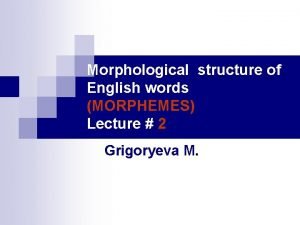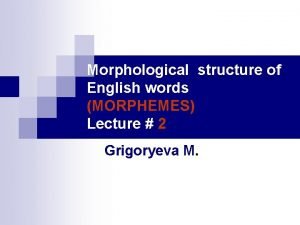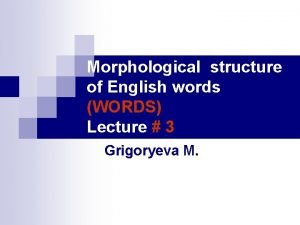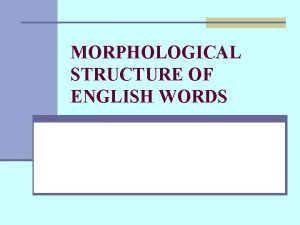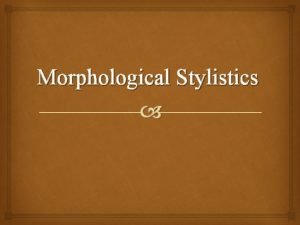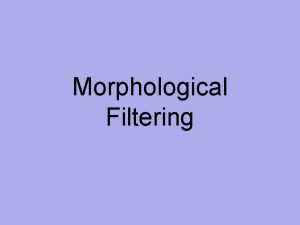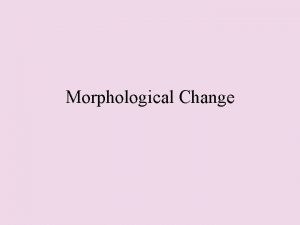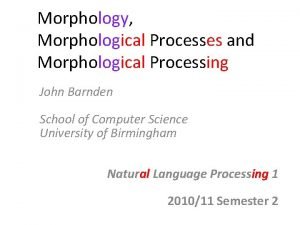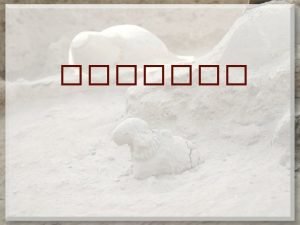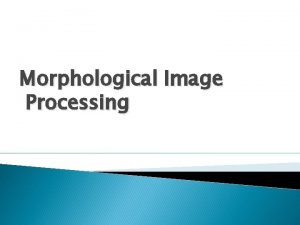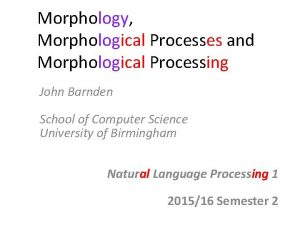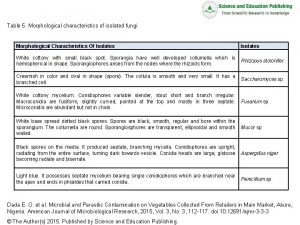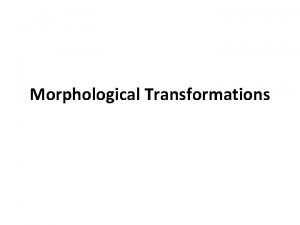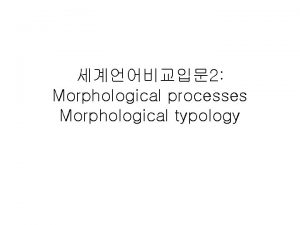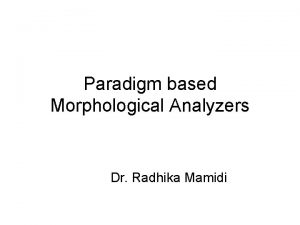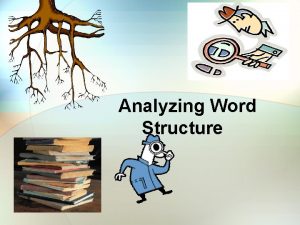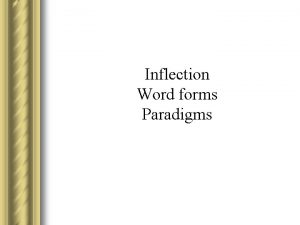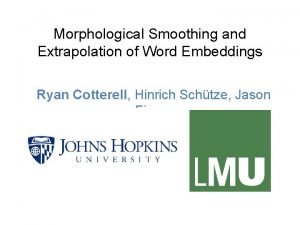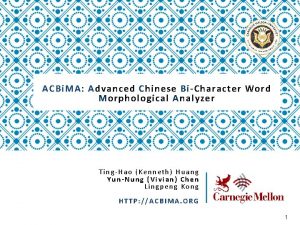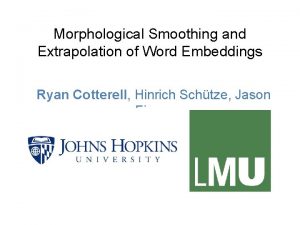Identifying a Word Morphological Structure of the Word










































- Slides: 42

Identifying a Word. Morphological Structure of the Word Lecture 5

n 5. 1. Problems of the Definition of the Word n 5. 2. Lexical and Grammatical Words n 5. 3. Morphological Structure of the Word n 5. 4. Types of Morphemic Segmentability

The Problems of the Definition A word has many different aspects: n 1) phonological, as it has a sound form; n 2) morphological, as it is a certain arrangement of morphemes; n 3) syntactic, as it may occur in different word forms and signal different meanings.

The Problems of the Definition A word is defined as: n minimum free form (L. Bloomfield) n association of a given meaning with a given group of sounds susceptible of a given grammatical employment (A. Meillet)

The Problems of the Definition A word is an autonomous unit of the language in which n a particular meaning is associated with n a particular sound complex n capable of a particular grammatical employment and n able to form a sentence by itself.

The Problems of the Definition n Orthographically words may be spelt differently: teapot, tea pot. Words are written separately, but not all words fit this category, e. g. will not – two words; cannot – one word. n There may be found different forms but different forms are not necessarily regarded as different words, e. g. teach, teaches, taught, teaching; nice, nicer, nicest – are not separate words.

The Problems of the Definition n Some words can have the same forms but completely different and unrelated meanings, e. g. fair. n The existence of idioms and phrasal verbs seems to upset attempts to define words in any formal way, e. g. to kick the bucket – “to die”, to put off – “to postpone”.

The Problems of the Definition n A lexeme is the abstract unit which underlies some of the variants we have observed in connection with 'words'. n Thus, teach is the lexeme which underlies some of the variants teach, teaches, taught, teaching which are the word forms.

The Problems of the Definition n The term lexeme is also connected with more than one word form expressed by such lexical items as: n Multi-word verbs, e. g. , to catch up with; n Phrasal verbs, e. g. , to clear up, to switch off; n Idioms, e. g. , kick the bucket.

Lexical and Grammatical Words n Lexical words are full words or content words. They include nouns, adjectives, verbs, adverbs and belong to the open classes of words. They carry a higher information content and are syntactically structured by the grammatical words. n LW form an open class of words because they are subject to diachronic change, changes in form and meaning over a period of time.

Lexical and Grammatical Words Nouns n A noun is a naming word. It gives the name to a person, place, thing, etc. n Most nouns possess the category of number and have a plural form ( s/ es). n Some words make their plural forms in a different way. n Others never change their singular forms to make their plurals. n Some nouns never occur without the plural marker.

Lexical and Grammatical Words Adjectives n Adjectives denote a property or quality of an object. All adjectives fall into two groups: gradable and non gradable. n Gradable adjectives take grammatical forms and represent degrees of comparison: positive, comparative, superlative. n Adjectives in English may appear either before a noun or after a verb, e. g. juicy apple, get wet, be happy. Not all adjectives appear in both positions.

Lexical and Grammatical Words Verbs n There are two classes of verbs – lexical and auxiliary verbs. Lexical verbs denote actions or states. Each verb has five associated grammatical words, e. g. , ask – asks – asked – asking – asked; go – goes – went – going – gone. n Verbs like ask are regular, they form the majority of verbs in English. Irregular verbs like go have different forms.

Lexical and Grammatical Words Adverbs n Two classes of adverbs – degree and general. n Degree adverbs are a small group of words like quite, far, very, more, and most. They always appear with either an adjective or a general adverb, e. g. She drives very well. His story is quite interesting. n General adverbs form a large class and may appear without a degree adverb, e. g. He cooks well. Adverbs denote degree, manner, place, time. Adverbs have no inflected forms, they take comparisons like adjectives.

Lexical and Grammatical Words n Grammatical words comprise a small class of words that includes pronouns, auxiliary verbs, determiners, prepositions, conjunctions. They are also known as functional words, or empty words. n Grammatical words constitute a closed class, i. e. they do not accept new members.

Lexical and Grammatical Words n Pronouns are words that take the place of nouns, noun phrases. Different types: personal (I, we, she), demonstrative (this, those), possessive (mine, yours), interrogative (whom, whose, which), etc. n Auxiliary verbs such as have, do, did, will determine the mood, tense, or aspect of another verb in a verb phrase. n Conjunctions serve to connect words, phrases, clauses, or sentences, e. g. and, but, for, nor, yet, so.

Lexical and Grammatical Words n Determiners introduce nouns; they are articles (a, an, the), quantifiers (some, much). n Prepositions are words that show the relationship between a noun or pronoun and other words in a sentence. They indicate locations in time or space (at, in), agency (by), comparison (like, as. . . as), direction (to, toward, through), place (at, by, on), possession (of), purpose (for), source (from, out of), and time (at, before, on), etc.

Morphological Structure Words consist of morphemes. n A morpheme is the smallest meaningful unit of speech, which cannot be split up into smaller segments. n A morpheme is not autonomous. Morphemes occur in speech as constituent parts of words, not independently.

Morphological Structure n A word may consist of a single morpheme or contain several, e. g. shelf (one morpheme), indisputable (3 morphemes) – in-disput-able. n The morpheme in can be found in words insignificant, inexpensive; the morpheme able – in words excusable, reliable; the morpheme dispute – in such words as disputing, disputes.

Morphological Structure n Some morphemes have only one phonological form, while others may have a number of variants which are known as allomorph. n Pronounce: please, pleasing, pleasure, pleasant. n The representations of the given morpheme are called allomorphs or morphemic variants.

Morphological Structure n An allomorph is a positional variant of a morpheme occurring in a specific environment and characterized by complementary distribution.

n Cows, cats, pigs, horses, sheep, oxen, mice Allomorphs occur among prefixes. n The morpheme in may have the following phonological forms: n im occurs before bilabials – impossible; n ir occurs before r – irregular; n il occurs before 1 – illegal; n in occurs before other consonants and vowels – inability, indirect.

Morphological Structure n Semantically morphemes fall into root- morphemes and non-root morphemes. n The root morphemes are the lexical centers of the words, as the basic constituent part of a word without which the word is inconceivable.

Morphological Structure n Words hairless, lofty, darkness, refill – the root morphemes are hair, loft, dark, fill n The root morpheme is the lexical nucleus of a word; it has an individual lexical meaning shared by no other morpheme of the language. n The root morpheme is the morpheme common to a set of words making up a word cluster, e. g. dance in to dance, dancer, dancing.

Morphological Structure n Non root morphemes include inflectional morphemes (inflections) and derivational morphemes (affixes).

Morphological Structure n Inflections carry only grammatical meaning, they build different forms of one and the same word, e. g. cheap, cheaper, cheapest. n Affixes supply the stem with components of lexical and lexico grammatical meaning. They are classified into prefixes and suffixes, e. g. chain – unchain, broad - broaden.

Morphological Structure n A suffix is a derivational morpheme following the stem and forming a new derivative in a different part of speech or a different word class, e. g. , -en, y, less in hearten, hearty, heartless. n A prefix is a derivational morpheme standing before the root and modifying meaning, e. g. , to hearten to dis hearten.

Morphological Structure Structurally morphemes fall into n free morphemes, n bound morphemes, n semi-free (semi-bound morphemes).

Morphological Structure n A free morpheme is defined as one that can occur by itself as a whole word, e. g. cloudy – cloud, excusable – excuse. A great number of root morphemes are free morphemes, e. g. child in the words childhood, children, childish is naturally qualified as a free morpheme because it coincides with one of the forms of the noun child.

Morphological Structure n A bound morpheme is attached to another and is a constituent part of a word. Bound morphemes are of two types: inflectional morphemes and derivational ones. n Inflectional morphemes: watch – watches, look – looked, etc. n Derivational morphemes are affixes, e. g. ness, -ship, -ize, dis-, de- in the words like happiness, relationship, to displease, to demoralize.

Morphological Structure n Semi free or semi bound morphemes can function in a morphemic sequence both as an affix and as a free morpheme, e. g. half-ready, seaman, womanlike.

Morphological Structure n According to the number of morphemes words fall into monomorphic and polymorphic. n Monomorphic or root words consist of only one root morpheme, e. g. long, car, make, drive, etc.

Morphological Structure n All polymorphic words according to the number of root morphemes are classified into two subgroups: monoradical or root words and polyradical words, i. e. words which consist of two or more roots.

Morphemic Segmentability n As far as the complexity of the morphemic structure of the word is concerned all English words fall into two large classes: n segmentable words, those allowing of further morphemic segmentation, e. g. , quickly, fearless, agreement; n non-segmentable words, e. g. , house, girl, cat, woman.

Morphemic Segmentability n The main aim of the morphemic analysis is to split a word into its constituent morphemes, determine their number and type. n It's called the method of immediate and ultimate constituents.

Morphemic Segmentability DISAGREEMENT DISAGREE DIS AGREE MENT

Morphemic Segmentability There are three types of morphemic segmentability: n complete, n conditional and n defective.

Morphemic Segmentability Complete segmentability: n the individual morphemes are clearly singled out within the word and can easily be isolated. The constituent morphemes are met in other words with the same meaning, n e. g. speechless – two morphemes: speech and less. n Speech → speech, speeches, less → nameless, useless.

Morphemic Segmentability Conditional segmentability: n the segmentation into the constituent morphemes is doubtful for some semantic reasons, e. g. retain, contain, detain. n The words can be split into the following re–tain, con–tain, de–tain. The constituent part tain unites these three verbs, but we cannot trace the common meaning in each verb, consequently we cannot regard -tain as a morpheme.

Morphemic Segmentability n Similarly we may find re-, con-, de- in other verbs (recall, remind, consist, confuse, delay, defeat), but each group of words does not share a common meaning. Such morphemes are called pseudo-morphemes or quasimorphemes.

Morphemic Segmentability n Defective segmentability is the property of words whose constituent morphemes are seldom or never met in other words. n A unique morpheme is isolated and understood as meaningful because the constituent morphemes display a more or less clear denotational meaning. cranberry → two morphemes: cran and berry. n The morpheme berry occurs in strawberry, blackberry, etc. n Cran does not recur in any other English word, thus, this morpheme is unique.

Thank you for your attention. Don’t forget to get ready for the seminar.
 Adjective
Adjective How to identify clauses
How to identify clauses Identify the essential
Identify the essential Morphological structure of english words
Morphological structure of english words Semi-bound morphemes
Semi-bound morphemes Polyradical words
Polyradical words Structure of english words
Structure of english words One third 1/3
One third 1/3 Kalulu the hare analysis
Kalulu the hare analysis Hình ảnh bộ gõ cơ thể búng tay
Hình ảnh bộ gõ cơ thể búng tay Slidetodoc
Slidetodoc Bổ thể
Bổ thể Tỉ lệ cơ thể trẻ em
Tỉ lệ cơ thể trẻ em Chó sói
Chó sói Glasgow thang điểm
Glasgow thang điểm Hát lên người ơi alleluia
Hát lên người ơi alleluia Các môn thể thao bắt đầu bằng từ đua
Các môn thể thao bắt đầu bằng từ đua Thế nào là hệ số cao nhất
Thế nào là hệ số cao nhất Các châu lục và đại dương trên thế giới
Các châu lục và đại dương trên thế giới Công thức tính thế năng
Công thức tính thế năng Trời xanh đây là của chúng ta thể thơ
Trời xanh đây là của chúng ta thể thơ Cách giải mật thư tọa độ
Cách giải mật thư tọa độ Phép trừ bù
Phép trừ bù độ dài liên kết
độ dài liên kết Các châu lục và đại dương trên thế giới
Các châu lục và đại dương trên thế giới Thơ thất ngôn tứ tuyệt đường luật
Thơ thất ngôn tứ tuyệt đường luật Quá trình desamine hóa có thể tạo ra
Quá trình desamine hóa có thể tạo ra Một số thể thơ truyền thống
Một số thể thơ truyền thống Cái miệng nó xinh thế chỉ nói điều hay thôi
Cái miệng nó xinh thế chỉ nói điều hay thôi Vẽ hình chiếu vuông góc của vật thể sau
Vẽ hình chiếu vuông góc của vật thể sau Thế nào là sự mỏi cơ
Thế nào là sự mỏi cơ đặc điểm cơ thể của người tối cổ
đặc điểm cơ thể của người tối cổ V. c c
V. c c Vẽ hình chiếu đứng bằng cạnh của vật thể
Vẽ hình chiếu đứng bằng cạnh của vật thể Phối cảnh
Phối cảnh Thẻ vin
Thẻ vin đại từ thay thế
đại từ thay thế điện thế nghỉ
điện thế nghỉ Tư thế ngồi viết
Tư thế ngồi viết Diễn thế sinh thái là
Diễn thế sinh thái là Dạng đột biến một nhiễm là
Dạng đột biến một nhiễm là Số nguyên tố là
Số nguyên tố là Tư thế ngồi viết
Tư thế ngồi viết



